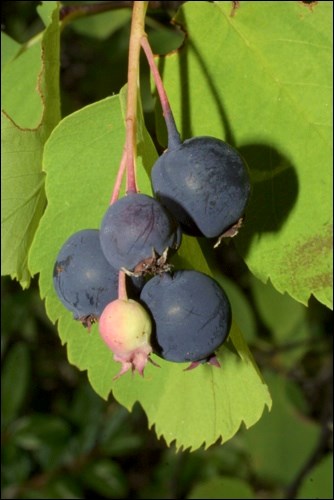David Thompson, an early Canadian explorer, wrote one of the first descriptions of the much loved saskatoon berry in 1784:
“On the great plains there is a shrub bearing a very sweet berry of a dark blue color, much sought after. Great quantities are dried by the natives. In this state the berries are sweet as the best currants ... The wood is preferred for their arrows and bows as it is weighty, pliant and non-elastic. It ought to be cultivated in England and Canada.”
Early settlers quickly adopted the berries for use in jams, jellies, preserves, pies and wine. By the turn of the last century, pioneers were transplanting saskatoons from the wild to their prairie homesteads. And it’s not just for food production. With their early spring flowers coupled with fall colors ranging from yellow to orange with the occasional purple, saskatoons have valuable ornamental features.
Almost all saskatoon cultivars are superior selections from the wild, surviving winter temperatures of –50 C or lower. They have a wide geographic distribution and are highly variable in terms of height (one to seven metres), flowering times (early May to early June), fruit (size, taste, ripening uniformity, yield) and suckering (vigorous – ideal for commercial growers, farms and acreages, or “stay put”– more suited to a small urban lot).
Saskatoon berry leaves are oval to circular and singly toothed. Attractive clusters of white flowers are produced before the leaves are fully unfurled. Once open, the flowers and small developing fruit can be injured by light frosts (about –3 C). Saskatoons are self-fertile and do not require cross-pollination from a different cultivar for fruit production. The berries ripen six to eight weeks after flowering, in late July. Plants begin to bear fruit at three to five years of age, coming into full production by seven to eight years. With proper care, they will continue fruiting until 30 to 50 years old.
The following are descriptions of just a few of the available cultivars.
Honeywood flowers later than most cultivars, generally avoiding frost damage. It has large fruit (13 to 15 millimitres) in clusters of up to 15 berries with a mild flavor, ripening over two to three weeks. It’s very productive beginning at an early age. The plants are 2.5 to 3 metres tall and wide with spreading branches and moderate suckering.
Thiessen blooms early making it more susceptible to frost damage. The large berries (15 millimtres) have good flavor. It is very productive and the fruit ripens over a long period. The plant is four to five metres tall x 2 m wide with a rounded form.
‘Martin’ is a heavy producer with large fruit (15-20 mm) of excellent flavour that ripens uniformly. The plants are 2.5 m tall by two metres wide with a compact form.
Northline flowers and fruits a bit later than other cultivars. The berries are 16 mm, full flavored, sweet, and very productive from an early age. They ripen at the same time. The plants are 1.5- 2 m tall x 1.5 m wide, upright and slightly spreading and sucker freely.
Smoky is probably the most common commercially grown cultivar in Canada. It flowers late enough to usually avoid damage by spring frosts. The berries are 14 millimetres, fleshy, round, sweet, mild and in medium-sized clusters. It is very productive with consistent annual production. The plant is three metres tall by 2.5 metres wide, upright, and spreading with a suckering habit.
Next week – care and keeping of saskatoon berry bushes.
Williams is the author of the newly revised Creating the Prairie Xeriscape and the Saskatoon Forestry Farm Park & Zoo: A Photographic History. Just back from Morocco, Sara will also be hosting a tour to Ireland in September. For information, call Ruth at 1-888-778-2378.
—This column is provided courtesy of the Saskatchewan Perennial Society (www.saskperennial.ca; [email protected]). Check out our Bulletin Board or Calendar for upcoming garden information sessions.




